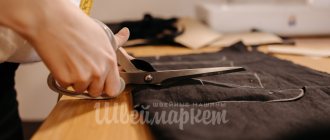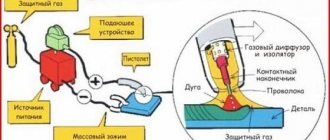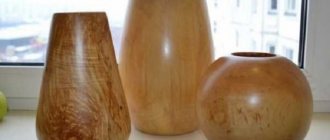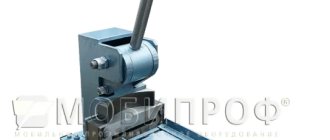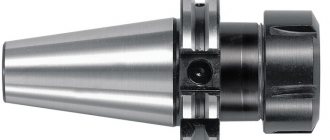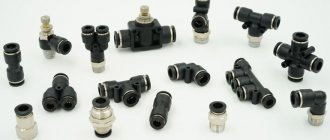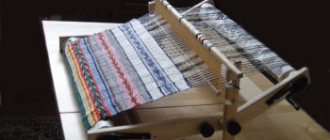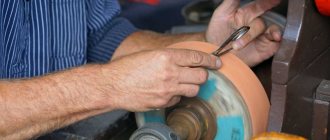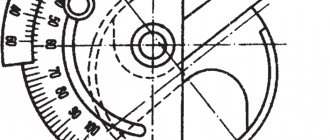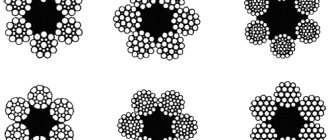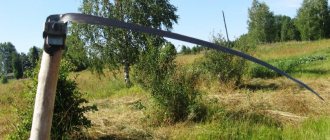Guillotine shears – equipment for cutting rolled metal. The main working elements of the devices are movable and stationary knives made of hard tool or high-speed steel.
The cutting process is shown in the figure, where:
- Desktop.
- Metal sheet.
- Fixed blade.
- Movable knife.
The process is carried out by moving the movable knife down; the principle of operation of the equipment resembles the operation of a guillotine.
Scheme of operation of a guillotine knife
Cutting is a sequence of the following operations:
- The workpiece is fixed in the clamping device (long products are fed into the working area).
- The movable knife moves, displaces layers of metal and cuts the workpiece.
- The cut is fed to the receiving device.
The result is an even cut without significant defects. Equipment for cutting metal of considerable thickness cuts the workpiece; such parts often require additional processing of the cutting line.
Guillotine shears are used for cutting blanks, finished parts or products from all types of rolled metal. The equipment can be used autonomously, as part of production lines, or installed directly on the machine.
What are guillotine shears?
Guillotine is specialized equipment for cutting metal sheets. The cutting can be either longitudinal or transverse, but cutting with guillotine shears will not work. The length of the workpiece is practically unlimited. The design of the guillotine allows you to make a precise cut without defects, protecting the top polymer layer.
Main structural elements:
- bed;
- knives.
The bed is two racks connected by a beam and traverses. It is equipped with a work table for feeding metal. The lower knife is usually fixed, and the upper one is mounted on a movable beam. Both are made from high-alloy hardened steel. There are designs with a lower movable blade.
| Length | 110 – 2000 mm |
| Thickness | 12 – 120 mm |
| Width | 50 – 200 mm |
Table 1. Characteristics of guillotine shear knives
Modern guillotine shears are equipped with a graduated stop for serial cutting and a limiter for approximate size adjustment.
The cut material falls onto the return pallet. To prevent the machine from being overloaded, it is equipped with a safety pin, which, in the event of a critical point, is cut off, stopping the cutting process.
Metal guillotine cutting process
Guillotine shears consist of 2 adjacent knives located in an oblique direction to each other, at a slight angle. They rest on brackets or are shifted in a straight line so that the cutting of sheet metal with a guillotine occurs gradually. This fact causes a reduction in the required force for the cutting process.
It is worth noting that there are several types of guillotine shears, which differ not only in power and strength, but also in size, scope of application and nature of work.
Manual guillotines are used in small workshops for cutting thin sheets. Mechanical equipment is used to work with material up to 8 mm thick. Large industrial machines cut workpieces with a thickness of more than 30 mm well.
The characteristic feature of the guillotine is that the material being processed is not subjected to thermal effects, as with laser or plasma cutting. This is important because, for example, heat treatment changes the physical properties of the metal. The quality of final processing depends on the following factors:
- type of material being processed;
- cutting angle;
- width of the space between the blades;
- general condition of the knives.
The result is largely influenced by the accuracy of the settings performed and the functionality of the equipment.
Working principle of guillotine shears
Before starting to work with the machine, you must study the operating instructions for guillotine shears.
The guillotine was used back in the 18th century, but was used only as an instrument of execution. The purpose of modern guillotine shears has changed, but the principle remains. Cutting occurs by lowering the blade, raised to a certain height.
- Sheet metal enters the work table through the feeder and is aligned with stops and stops.
- The clamping device fixes the metal, and the drive is turned on (hydraulic drive, pneumatic drive, electric drive).
- The upper knife descends and, together with the lower knife, cuts the material.
- The final material is thrown into a chute.
Application of guillotines for metal
The scope of application of guillotine machines is the metalworking industry. Equipment of this type is used to perform direct cuts of rolled steel, as well as rolled steel made of non-ferrous metals and alloys, with the need to divide one sheet into several parts of the same standard or different sizes.
Depending on the technical parameters and type of drive, the guillotine can be used for the manufacture of products both in piece production and in mass production.
Instructions for working with guillotine shears
Guillotine shears are a highly dangerous mechanism, so you need to work with them in compliance with the clear rules prescribed in the labor safety instructions. Important:
- Before starting work, put on special clothing, remove foreign objects and check the serviceability of the tool.
- When working with a guillotine, use gloves, do not put your hands under the blades and do not use dull knives.
- After finishing work, clean and lubricate the machine, take off your overalls and take a shower.
These are not all the points in the instructions for working with guillotine shears. The complete instruction manual can be viewed here. It must be remembered that each machine has its own characteristics, so it is worth reading the operating instructions for the guillotine shears of the desired model. They may differ:
- drive;
- type of knives;
- acceptable sheet size;
- productivity;
- power;
- number of operations.
The process of separating metal consists of cutting and breaking. A good guillotine provides about 90% cutting and 10% scrap. This way the cut area is smooth and does not require additional processing. Dull knives or incorrect machine settings lead to a deterioration in the ratio in favor of scrap, creating a burr that can cut your hands.
Automation
The ability to automate the metal cutting process opens up wide possibilities in metalworking. This allows you to optimize production processes, which for many companies means significant time savings and reduced costs per operation.
Among the most popular systems on the market that automatically support the operation of the guillotine, we can highlight the hydraulic table, which fully matches the specific type of element during processing, and increases the cutting accuracy, as well as holding the workpiece in the optimal position.
To automate guillotines, systems are often used that ensure the movement of processed products. Systems of this type allow spontaneous movement of the processed material outside the machine, using specialized drive belts.
Types of guillotine shears
According to the type of drive, guillotine shears are divided into:
- manual;
- hydraulic;
- pneumatic;
- electromechanical;
- combined.
Manual guillotine shears
The manual guillotine is widely used not only in large production, but also in auto repair shops and even home garages. No electricity is needed to operate, and the blades can handle thin metal, plexiglass, plastic, rubber and cardboard. Ideal for solving everyday problems. It is activated by mechanical action on a lever attached to the blade.
Hydraulic shears
Hydraulic shears are common in medium and large factories. High cutting accuracy and adaptability to various sizes of metal have made these scissors quite popular. Large machine-building companies also prefer hydraulic guillotines with the ability to cut metal about 6 meters wide and more than 20 millimeters thick. A force of 500 MPa is applied along the entire length of the sheet. The gap between the knives is adjusted automatically or manually. Sometimes hydraulic shears are equipped with CNC, which facilitates mass production, photo sensors and protective screens.
Pneumatic guillotine
Not a single large-scale production can do without a pneumatic guillotine. For its operation, a compressor or a central line with compressed air is used. High accuracy and speed of work allows us to obtain a certain number of high-quality parts in a short time. The operating principle is similar to hydraulic shears.
Electromechanical shears
The most precise method of cutting metal is achieved using electromechanical guillotine shears. The dimensions of the workpiece are calculated by a built-in computer, and the knife is driven by a motor. Such guillotines are cheaper than hydraulic ones, but consume a large amount of electricity, which is why they are used less often.
Hydraulic drive
The hydraulic drive in the case of metal guillotines can significantly increase their strength and operating capabilities. Main advantages of hydraulic equipment:
- high durability;
- quick start;
- smooth operation with easy speed control;
- the ability to reduce the weight and dimensions of the device without losing its operating efficiency;
- minimal risk of overload;
- high processing accuracy;
- low cost of maintenance and repair.
Comparison of guillotines
| View | Metal thickness, mm | Type of metal | Metal tensile strength | Sheet width, m | Productivity, strokes/min | CNC |
| Hydraulic | 0,4 – 40 | Stainless steel, aluminum, titanium, corrugated sheeting, galvanized, fittings, black steel | Up to 500 MPa | 1 — 3 | 8 — 20 | + |
| Electromechanical | 0,25 – 12 | (same as above) | Up to 500 MPa | 1 – 3 | 1 – 60 | + |
| Pneumatic | 0,2 – 12 | (same as above) | Up to 500 MPa | 1 – 2,5 | 1 – 60 | + |
| Manual | 0,2 – 1,5 | Sheet steel, corrugated sheets, galvanization, fittings | Up to 400 MPa | 0,1 – 2,5 | 2 – 5 | — |
Table 2. Comparison of guillotine shears
Comparing the values from the table and the price of the machines, it becomes clear why the hydraulic guillotine is the most common. It is much cheaper than electromechanical and pneumatic, but allows you to work with thick metal, which is common in mass production. There are enough manufacturers of hydraulic shears, but the title of the best is held by machines of the NA and NG brands of domestic engineering giants due to high-quality assembly and relative cheapness.
Design and principle of operation
The design of guillotines may be different, but its main elements remain unchanged. These include:
- The working part is an inclined knife, which is mounted on a special movable beam. This item is replaceable.
- A frame that is designed to connect all structural components into a single whole and ensure their interaction. Typically this device consists of a channel and two vertically located racks, which, in turn, are also connected by channels in the upper and lower parts.
- Table. Mounted on racks using a bolted connection. The lower knives are fixed on its surface. The table is equipped with extensions with T-shaped grooves, in which stops are attached for cross cutting. These elements are removed during longitudinal felling.
- Drive unit. This component of the design is responsible for the movement of movable knives, which move up and down in a vertical plane. The drive has sufficient power to overcome the resistance force of the material, with a certain margin.
- Pressure beam. Designed for fixing metal sheets at the workplace. It is equipped with automated protection devices that protect the worker’s hands from possible injury.
- Rear support. This element holds the sheet of metal in place during the slitting process. The device is equipped with two movable slats that can be installed closer or further from the cutting edge. Adjustment is made by manually rotating the corresponding flywheels.
- Balancer for guillotine knives. Used to fix the knife beam in the upper position at the end of each working or idling stroke, as well as for the purpose of repairing or replacing the device.
- Intermittent brake. Ensures that the moving elements of the machine stop in the uppermost position and compensates for their inertia.
An electromagnetic device is used to control the guillotine. It is started by pressing a special button or pedal. There are several operating modes of the machine: single stroke or cyclic movements.
The technology of cutting metal using a guillotine is highly efficient. The process of dividing a sheet into parts consists of exposing the material to an inclined knife with an optimal level of sharpening. The cutting element is made of high strength tool steel.
The pressure force of the knife significantly exceeds the tensile strength of the metal sheet. Under its influence, the structure of the material is destroyed in the narrowest possible area. The resulting cut does not require additional processing.
One person is enough to operate the guillotine machine. The operating algorithm of this type of equipment is based on the operating principle of ordinary scissors. It is as follows:
- Automatic feeding of the workpiece to the work table and its alignment (for transverse cutting - along the stops, for longitudinal cutting - along the stops).
- Fixing the sheet in a given position using a clamping beam.
- Pressing a button or pedal to turn on a drive that acts on the knife directly or through a special mechanism.
- Starting the movement of the knife in the downward direction, cutting the metal sheet, reaching the lower position with the knife and returning the cutting element to the initial position by moving it in the opposite direction.
- Automatic lifting of the pressure beam with release of the workpiece and its subsequent removal from the work table or movement to the stops to make the next cut.
The entire described cycle of operation of a guillotine machine, taking into account the preparatory stage, takes a few seconds. Therefore, this equipment is most suitable for mass production.
High cut quality and preservation of the metal structure contribute to a significant reduction in time and energy costs.
Working rules and safety precautions at work
In order to avoid injuries at work when working with a guillotine, it is important to comply with the following requirements:
- Availability of protective clothing: protective apron, glasses, dry shoes with non-slip soles. Before work, it is necessary to remove all protruding or hanging objects, such as watches, bracelets, rings, etc.
- Equip the work area with fencing structures.
- Before starting up the machine, make sure it is in good working order and, if necessary, take repair measures. Check the quality of the lubricant, the integrity and performance of the components. Inspect the work surface, clean it if necessary or replace it if damage is found.
- Before turning on the equipment, remove unnecessary tools, fixtures and other foreign objects from the workbench.
Examples from the catalog
Saber-type guillotine MG-1300 METAL MASTER. Specifications:
- model - MG-1300 METAL MASTER;
- bending length - 1300 mm;
- thickness of processed metal - 1 mm;
- LxWxH (mm) - 1700x300x800;
- weight - 85 kg;
- article - 068–2660–1;
- brand - Metal Master.
Manual guillotine Stalex Q01-0.8x2540. Specifications:
- width - 1320 mm;
- maximum cutting thickness for galvanized steel - 1.5 mm;
- material feed limiter - up to 840 mm;
- LxWxH (mm) - 1680x760x1150;
- weight - 491 kg.
What to look for when choosing a guillotine?
When choosing a guillotine, it is recommended to be guided by the following parameters:
- maximum thickness and length of cut;
- production volumes (piece or mass);
- required performance and cutting accuracy indicators;
- optimal list of functions.
It should be taken into account that multifunctional equipment with high power has certain features:
- high price;
- large dimensions;
- Possibility of installation only in rooms with a large area;
- high energy consumption.
